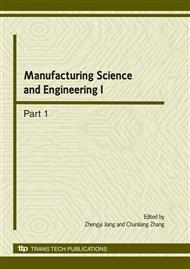p.4193
p.4197
p.4201
p.4206
p.4213
p.4217
p.4221
p.4225
p.4230
Synthesis and Photoluminescence Properties of Novel SnO2 Zigzag Nanoribbons
Abstract:
Novel single-crystalline SnO2 zigzag nanoribbons have been successfully synthesized by chemical vapour deposition. Sn powder in a ceramic boat covered with Si plates was heated at 1100°C in a flowing argon atmosphere to get deposits on a Si wafers. The main part of deposits is SnO2 zigzag nanoribbons. They were characterized by means of X-ray diffraction (XRD), field-emission scanning electron microscopy (FE-SEM), energy-dispersive X-ray spectroscopy (EDX), transmission electron microscopy (TEM) and selected-area electron diffraction (SAED). SEM observations reveal that the SnO2 zigzag nanoribbons are almost uniform, with lengths near to several hundred micrometers and have a good periodically tuned microstructure as the same zigzag angle and growth directions. Possible growth mechanism of these zigzag nanoribbons was discussed. A room temperature PL spectrum of the zigzag nanoribbons shows three peaks at 373nm, 421nm and 477nm.The novel zigzag microstructures will provide a new candidate for potential application.
Info:
Periodical:
Pages:
4213-4216
Citation:
Online since:
March 2010
Authors:
Price:
Сopyright:
© 2010 Trans Tech Publications Ltd. All Rights Reserved
Share:
Citation:


